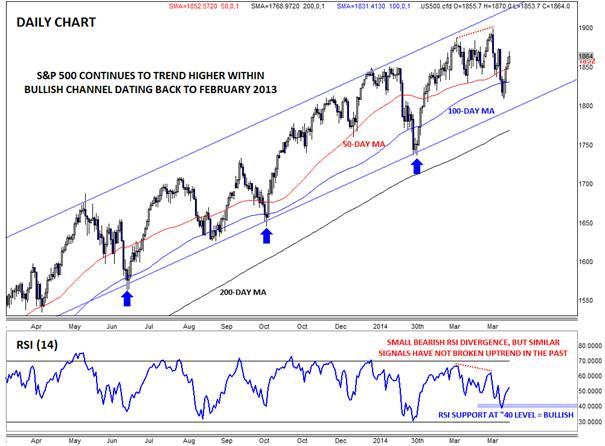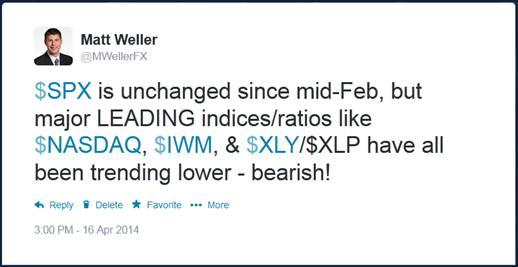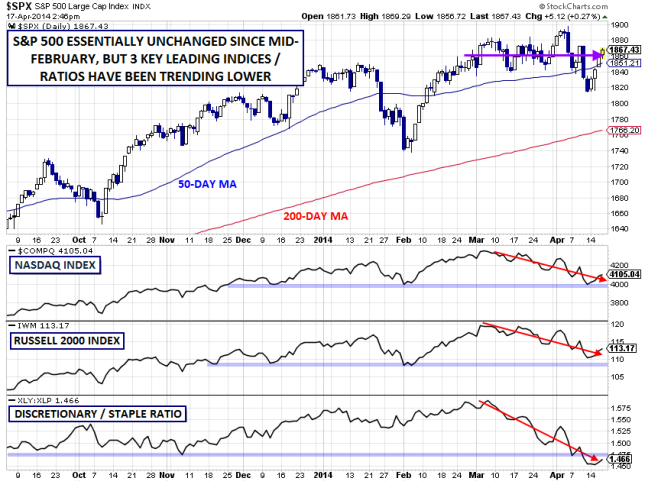![]()
The US Stock Market, as measured by the S&P 500 index, has now gone nearly two full years without seeing a 10% correction, despite concerns about deflation, inflation, government shutdowns, Fed tapering, China slowing down, and unrest in Crimea, among others. With the US entering the meat of another quarterly earnings season, it’s worth revisiting the fundamental and technical drivers of the market.
Fundamentals: A Weak Start to Earnings Season
As my colleague Kathleen Brooks noted earlier this week, equity P/E ratios are slightly elevated, but far from historically dangerous levels. There are some longer-term concerns with elevated profit margins and multi-year valuation measures, but the biggest concern for shorter-term traders is the current earnings season, which is shaping up to be one of the toughest in recent memory due to inclement weather in Q1.
According to data from Factset, 66% of the 82 companies that have reported earnings thus far have beat analyst estimates for earnings and 50% have exceeded consensus revenue estimates. While these numbers may initially sound solid, they compare unfavorably with the 4-year averages of 74% for earnings and 58% for revenues. In fact, the S&P 500 is on track for its first decline in average earnings since Q3 2012. With nearly one-third of S&P500 companies (161 firms) scheduled to report earnings this coming week, traders will be keeping a close eye on whether these trends will continue.
Technicals: Leading Indices a Possible “Canary in the Coal Mine�
At first glance, the technical picture for the S&P 500 remains strong. The index is still within a rising bullish channel that dates all the way back to February of last year , and all three major moving averages (50-, 100-, and 200-day) are in consistent uptrends. Meanwhile, the RSI indicator has just found support in the key “40†zone, indicative of an overall uptrend. There was a small bearish RSI divergence near the recent highs, but the index uptrend has easily weathered similar divergences in the past.
The S&P 500 is essentially unchanged since mid-February, but as I noted on twitter Wednesday, some of the other widely-followed stock market indices are waving caution flags:
For one, the NASDAQ index, which is more heavily weighted in economically-sensitive technology stocks, has actually been putting in a series of lower lows and lower highs since peaking over a month ago. Similarly, the Russell 2000 index of small-cap stocks (smaller companies) has also been trending lower for over a month. Historically, these two indices have turned before the more widely-followed S&P 500 and Dow Jones Industrial Average at major turning points in the market. If they break below their YTD lows (4000 on the NASDAQ and 108 on the IWM), the selling pressure may accelerate from here.
The final sub-chart below requires a bit more explanation. As many readers may know, the S&P 500 can be further subdivided into sectors that share common characteristics. Two of the most widely followed sectors are the consumer discretionary and consumer staples sectors, which can give insight into how consumers are behaving (or at least, how investors anticipate consumers will behave).
For example, if consumers are concerned about the economic future, they may choose to put off nonessential (“discretionaryâ€) purchases like a new TV, car, or set of golf clubs. On the other hand, no matter how worried consumers are about the future, they will still have to buy essentials (“staplesâ€) like toothpaste and toilet paper.
Therefore, looking at the ratio between the two sectors (XLY/XLP, below) can provide a potential leading indicator for the stock market and the economy as a whole. In this case, that ratio is not painting a bullish picture, having already dropped to a 9-month low after peaking in early March.
At this point, the weakness in these three leading indices is not necessarily an immediate signal to act for S&P500 traders. But if we see start to see the bearish evidence pile up (especially if earnings continue to come in below estimates), the drops in these leading indicators could well prove to be the proverbial “canary in the coal mine†for the S&P 500 and DJIA.
This research is for informational purposes and should not be construed as personal advice. Trading any financial market involves risk. Trading on leverage involves risk of losses greater than deposits.
Recommended Content
Editors’ Picks
EUR/USD edges lower toward 1.0700 post-US PCE

EUR/USD stays under modest bearish pressure but manages to hold above 1.0700 in the American session on Friday. The US Dollar (USD) gathers strength against its rivals after the stronger-than-forecast PCE inflation data, not allowing the pair to gain traction.
GBP/USD retreats to 1.2500 on renewed USD strength

GBP/USD lost its traction and turned negative on the day near 1.2500. Following the stronger-than-expected PCE inflation readings from the US, the USD stays resilient and makes it difficult for the pair to gather recovery momentum.
Gold struggles to hold above $2,350 following US inflation

Gold turned south and declined toward $2,340, erasing a large portion of its daily gains, as the USD benefited from PCE inflation data. The benchmark 10-year US yield, however, stays in negative territory and helps XAU/USD limit its losses.
Bitcoin Weekly Forecast: BTC’s next breakout could propel it to $80,000 Premium

Bitcoin’s recent price consolidation could be nearing its end as technical indicators and on-chain metrics suggest a potential upward breakout. However, this move would not be straightforward and could punish impatient investors.
Week ahead – Hawkish risk as Fed and NFP on tap, Eurozone data eyed too

Fed meets on Wednesday as US inflation stays elevated. Will Friday’s jobs report bring relief or more angst for the markets? Eurozone flash GDP and CPI numbers in focus for the Euro.


